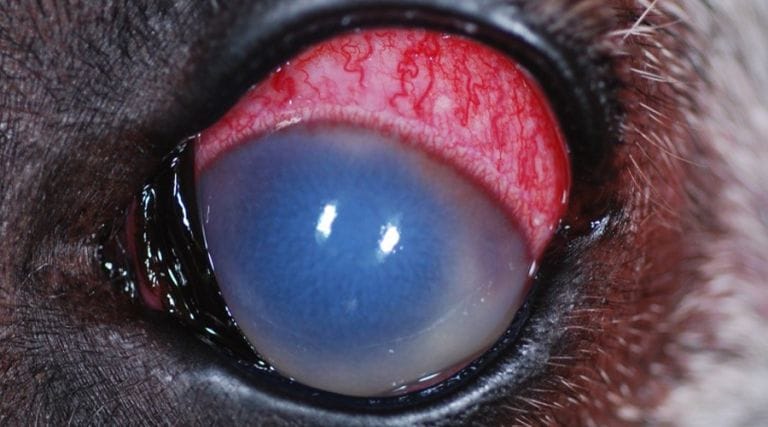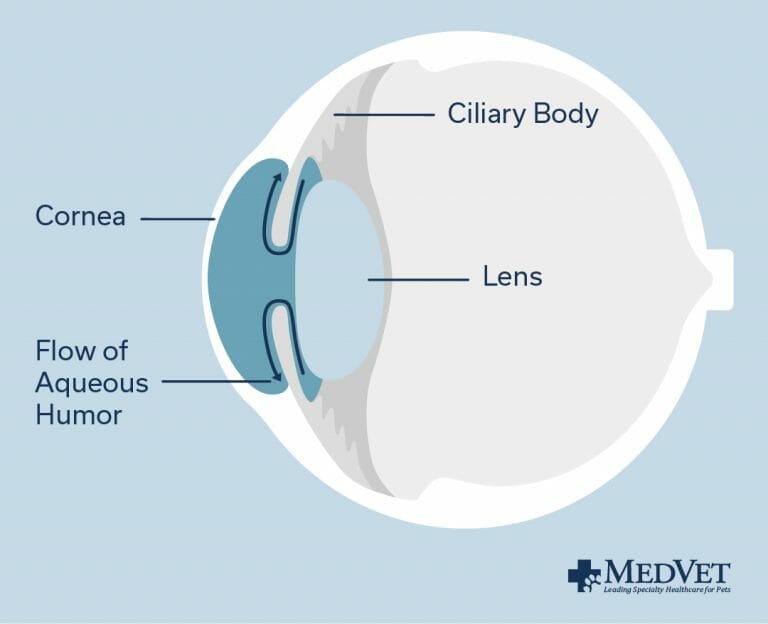Nearly 3 million Americans and more than 60 million people worldwide have glaucoma. As the second leading cause of blindness in humans, it makes sense that there is a focus every year on raising awareness about this “sneak thief of sight” with National Glaucoma Month. As we’re having conversations about this condition in humans, let’s talk about glaucoma in your pet.
Glaucoma occurs in nearly 2% of dogs in North America, and although a glaucoma diagnosis in cats is less common, they can be affected, too. Unfortunately, glaucoma is much more aggressive and more likely to cause blindness in animals compared to people.

What is Glaucoma?
The eye has fluid in it called the aqueous humor that is produced by a structure called the ciliary body. The fluid fills the chambers of the eye, giving it its shape and transporting nutrients like amino acids and glucose to parts of the eye that do not get supplied by the blood. Glaucoma is caused by a buildup of fluid in the eye that doesn’t drain properly. This creates increased pressure that can become painful and cause damage to the retina and optic nerve.
In a healthy eye, the amount of fluid produced is balanced by the amount that drains from the eye. With glaucoma, the drain stops working correctly. Think of it like a sink. In a normally functioning sink, the water that comes from your faucet goes down the drain. But, if the drain gets clogged, the water backs up. With glaucoma, it’s important to figure out why the drain stopped working.

Types of Glaucoma
Primary glaucoma refers to pets who have inherited the condition of an abnormal drain, causing aqueous humor to slowly become trapped over time. There are certain breeds that are more prone to glaucoma: Samoyed, Husky, Basset Hound, Cocker Spaniel, Beagle, Chow Chow, Maltese, Shar Pei, and Shiba Inu. If inherited glaucoma occurs in one eye, the chances of it also developing in the other eye are 50% within 12-18 months; so close monitoring can help detect changes in eye pressure earlier to help maintain vision as long as possible.
Secondary glaucoma stems from any number of other causes such as another disease or an injury to the eye. Secondary causes can include:
- Uveitis – an inflammatory condition in the eye that can end up blocking the drainage system.
- Instability of the lens and lens disorders like cataracts where the lens moves out of place and can end up blocking the drainage area or trapping fluid.
- Retinal detachment, tumors, cancer, or injuries to the eye can also end up causing a blockage.
Symptoms of Glaucoma
The progression of signs and symptoms varies between animals. You may first notice redness around the eye, tearing, squinting, or even a decreased appetite or activity level. Over time, the eye may begin to appear cloudy and larger or bulging. As it progresses, there can be further damage causing vision loss.
First symptoms include:
- Redness
- Tearing
- Squinting
- Decrease in appetite
- Decrease in activity level or hiding
- As the disease progresses, you may notice:
- Cloudy/blue eyes
- The eye getting larger or bulging

If the pressure stays high for too long, it can cause the lens to move or damage nerve cells which can lead to blindness. In acute cases with very elevated pressure, permanent blindness may occur within hours. So, it’s important to seek treatment right away if you think your pet has symptoms of glaucoma.
Diagnosing and Treating Glaucoma
Unfortunately, there is no cure for glaucoma, but it can be managed for a period of time if it’s treated properly. Like many conditions, this is most effective when it is diagnosed early on. Early intervention can extend the time to vision loss, and for some pets, that time may exceed their life expectancy.
Identifying the underlying cause of the glaucoma is key to identifying the best treatment options. A complete, detailed ophthalmic examination should be performed to determine the status of your pet’s vision, the stage of glaucoma, the underlying cause, and if there has been any permanent damage. Your veterinarian will measure intraocular pressure (IOP) using a tonometer. This quick test is non-painful, and most patients should measure under 20 mm Hg. If pressure is elevated, there are typically other symptoms to support a glaucoma diagnosis.
The goal of the treatments is to bring the pressure down in the eye. This typically begins with medication in the form of eye drops. Some medications work to decrease the production of the fluid and others focus on helping the fluid drain better. The effectiveness of the medications and how long they can work to control glaucoma and maintain your pet’s vision varies between patients. Since there is no cure, once medication begins, it will need to continue for the length of your pet’s life.
If medication alone becomes ineffective or if a pet is at a high risk of vision loss, laser surgery may also be used. One surgical option is called Endocyclophotocoagulation or ECPC. During the surgery, a strong beam of light is used to destroy the ciliary processes, the part of the eye that produces the aqueous humor, which then reduces the fluid production in the eye.

If Your Pet Becomes Blind
If blindness ensues, the focus becomes helping your pet manage the pain. One surgery, an Enucleation, involves removing the eye and sewing the eyelids shut. There are options that remove parts of the eye and replace them with a prosthesis which offers a cosmetic approach. Another option is a ciliary body ablation or chemical ablation where the veterinarian injects drugs that try to stop all intraocular fluid production. If done to an eye with vision, it will cause blindness, so this procedure is reserved for those that are blind and experiencing pain from the elevated pressure. In this case, the eye may remain cloudy but can decrease the pain and discomfort your pet is experiencing. All surgeries present different risks and those should be discussed with your veterinary ophthalmologist.
Although you can’t cure glaucoma, sight loss can often be slowed down, and you can ensure your pet is not in pain. It’s important to talk with your veterinarian and seek the help of a veterinary ophthalmologist if you believe your pet is experiencing signs of glaucoma. You can learn more about MedVet’s ophthalmology services or locate a specialist.